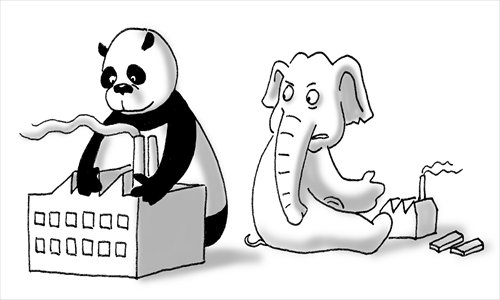


Illustration: Liu Rui/GT
China is rightly called the "factory of the world." Chinese products seem to be everywhere: Every day we see tags, labels and stickers displaying the legend "Made in China." In recent times, pundits have wondered if China will lose its spot as other economies offering cheap labor dull China's competitive edge. However, the availability of cheap labor is just one of the many factors that have made China a manufacturing hub, and it will take more than cutthroat desire for emerging economies to set up a business ecosystem that can compete with China's.
In September 2014, Indian Prime Minister Narendra Modi outlined the "Make in India" program, which aims at promoting India as an investment destination and a global hub for manufacturing, design and innovation.
After the launch of the "Make in India" initiative, recently there have been a lot of talks about manufacturing moving from China to India. The Western media likens it to a zero-sum game between the two Asian giants, and pose hypothetical question on whether "Make in India" can overtake "Made in China."
Demographics is the key, both to India's success and China's stagnation, in the coming years. The size of China's labor force decreased for the third year in a row in 2015, whereas India has demographics in its favor with the working age population set to rise by 125 million in the next decade. This vast human resource pool in India will keep wages competitive and provide scale of operations to the manufacturers. The employees, in turn, will add to the expanding affluent middle-class in India and thus providing a huge internal market.
India's government hopes that hundreds of Chinese companies will become part of India's industry. China has actively entered Indian markets in recent years. Lenovo Group announced that it began making smart phones in the Indian city of Chennai while Foxconn, the maker of iPhones, plans to open plants in all the major Indian states.
China has over 30 years of experience in producing goods for Western markets. In this time, Chinese companies have acquired a knowledge base to get to the point where it's not only cheap goods being made, but also high quality. While China moves into a middle-income country bracket, there would be movement of labor intensive low-cost goods manufacturing to other countries; but medium-to-high end manufacturing will still remain China's sweet spot.
Industrial production does not take place in isolation, but rather relies on networks. The business ecosystem in China has evolved quite a lot in the last 30 years. For example, Shenzhen has evolved as a hub for the electronics industry. It has cultivated an ecosystem to support the supply chain. There are so many established production ecosystems like this in China that it is very difficult to transfer production anywhere else.
Coinciding with the "Make in India" pitch, the Chinese government has launched a "Made in China 2025" campaign with a host of tax concessions in an effort to retain its manufacturing prowess. China will encourage high-tech imports, research and development (R&D) to upgrade "Made in China," according to the decision announced by the Chinese central government. Under the new campaign China will use tax breaks to encourage enterprises to upgrade their equipment and increase R&D efforts to improve the manufacturing industry.
China's new move aims to prompt the technical improvement of companies. The State Council asked government organs to implement the new measures as soon as possible to arm "Made in China" with advanced technology and equipment, encouraging more competitive products with high added value.
Thus China and India will together emerge as the manufacturing beacons of 21st century - with China focusing on the high-tech, high-value added manufacturing while Indian government's primary focus will be on high-volume and labor-intensive manufacturing.
We should try to combine "Make in India" and "Made in China" together. The key word in India-China relationship is development, which is a major factor of our cooperation. What gets less attention but matters more is that Indian imports from China are mostly capital goods that are industrializing India and retail merchandise is a small part of bilateral trade. Rather than stifle Indian manufacturing, importing from China is actually complementary to growing Indian exports.
The author is head of China &South East Asia at Invest India, a joint venture between Federation of Indian Chambers of Commerce and Industry and Government of India. ishu.investindia@gmail.com
 When a Chinese woman marries an Indian man
When a Chinese woman marries an Indian man Love beyond limit of heights in the world
Love beyond limit of heights in the world
 Photos of beautiful teacher hit the Internet
Photos of beautiful teacher hit the Internet Transparent Over-cliff Path Cracked Suddenly
Transparent Over-cliff Path Cracked Suddenly Bride-to-be tries to save drowned man
Bride-to-be tries to save drowned man Russian helicopter lands safely after being attacked in Syria
Russian helicopter lands safely after being attacked in Syria Models change clothes on street in Hangzhou
Models change clothes on street in Hangzhou Winding mountain road
in China
Winding mountain road
in China In pics: army beauties across world
In pics: army beauties across world Top 20 hottest women in the world in 2014
Top 20 hottest women in the world in 2014 Top 10 hardest languages to learn
Top 10 hardest languages to learn 10 Chinese female stars with most beautiful faces
10 Chinese female stars with most beautiful faces China’s Top 10 Unique Bridges, Highways and Roads
China’s Top 10 Unique Bridges, Highways and Roads Mind your meat
Mind your meat Used and abused
Used and abused Lifting one-child policy echoes people’s will
Lifting one-child policy echoes people’s will Muscle beach Beat ‘em to the punch at China’s seaside bodyguard school
Muscle beach Beat ‘em to the punch at China’s seaside bodyguard schoolDay|Week